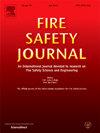Upward flame spread of flame-retardant cables with different ATH contents: Ignition, swelling, melting and flowing
IF 3.3
3区 工程技术
Q2 ENGINEERING, CIVIL
引用次数: 0
Abstract
To investigate the specific ignition and upward burning behaviors of flame retardant (FR) cables, series of experiments were conducted for FR-cables with mass fractions of aluminum hydroxide (ATH) of 58 %, 61 %, 64 %, 67 %, 70 % and 73 %, respectively. The results show that all studied FR-cables can be ignited by a coil heater delivering a heat flux of approximately 29 kW/m2, with the longest ignition delays for the samples containing the highest ATH content. Compared to FR-cables with 67 % and 70 % ATH contents, the melting and downward flowing are more pronounced for the samples of 58 %, 61 % and 64 % ATH, resulting in stronger burning with longer flame length and width. The upward flame spread velocities for all FR-cable samples are in the range of 1.2–1.6 mm/s and slightly smaller for cables with higher ATH contents. Specifically, the strong downward flowing of the melting liquid in the burning zone obviously slows down their upward flame spread. Dimensionless pyrolysis depth and flowing length are introduced to quantitatively describe the unique burning behaviors of FR-cables and a corresponding new flame spread model is developed based on energy conservation. The good agreement between the experimental and calculated data suggests its effectiveness and reasonability.
不同ATH含量阻燃电缆的向上火焰蔓延:着火、膨胀、熔化、流动
为研究阻燃电缆的点火特性和向上燃烧特性,对氢氧化铝质量分数分别为58%、61%、64%、67%、70%和73%的阻燃电缆进行了试验研究。结果表明,所有研究的fr -电缆都可以被线圈加热器点燃,其热流密度约为29 kW/m2, ATH含量最高的样品的点火延迟时间最长。与ATH含量为67%和70%的fr -电缆相比,ATH含量为58%、61%和64%的fr -电缆的熔融和向下流动更为明显,燃烧强度更强,火焰长度和宽度也更长。所有fr -电缆样品的火焰向上传播速度在1.2-1.6 mm/s范围内,ATH含量较高的电缆火焰向上传播速度略小。具体来说,燃烧区熔融液体强烈的向下流动明显减缓了其向上蔓延的火焰。引入无因次热解深度和流动长度来定量描述fr -电缆独特的燃烧行为,建立了基于节能的火焰传播新模型。实验数据与计算数据吻合较好,说明了该方法的有效性和合理性。
本文章由计算机程序翻译,如有差异,请以英文原文为准。
求助全文
约1分钟内获得全文
求助全文
来源期刊

Fire Safety Journal
工程技术-材料科学:综合
CiteScore
5.70
自引率
9.70%
发文量
153
审稿时长
60 days
期刊介绍:
Fire Safety Journal is the leading publication dealing with all aspects of fire safety engineering. Its scope is purposefully wide, as it is deemed important to encourage papers from all sources within this multidisciplinary subject, thus providing a forum for its further development as a distinct engineering discipline. This is an essential step towards gaining a status equal to that enjoyed by the other engineering disciplines.
 求助内容:
求助内容: 应助结果提醒方式:
应助结果提醒方式:


